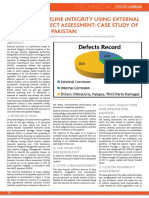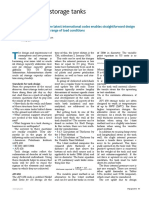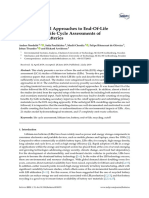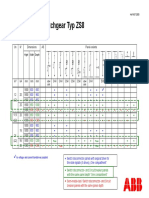"EduPotStat" - Construction and Testing of A Low Cost Potentiostat
"EduPotStat" - Construction and Testing of A Low Cost Potentiostat
Uploaded by
Dhammika RathnayakeCopyright:
Available Formats
"EduPotStat" - Construction and Testing of A Low Cost Potentiostat
"EduPotStat" - Construction and Testing of A Low Cost Potentiostat
Uploaded by
Dhammika RathnayakeOriginal Description:
Original Title
Copyright
Available Formats
Share this document
Did you find this document useful?
Is this content inappropriate?
Copyright:
Available Formats
"EduPotStat" - Construction and Testing of A Low Cost Potentiostat
"EduPotStat" - Construction and Testing of A Low Cost Potentiostat
Uploaded by
Dhammika RathnayakeCopyright:
Available Formats
IOSR Journal Of Applied Physics (IOSR-JAP)
e-ISSN: 2278-4861.Volume 12, Issue 5 Ser. III (Sep. – Oct 2020), PP 10-18
www.Iosrjournals.Org
“EduPotStat”: Construction and testing of a low cost potentiostat
R.M.D.P.K.Rathnayaka1, D. D.C. Wanniarachchi2, C. H. Manathunga3, R.
A.D.D. Dharmasiri3, W. K. I. L. Wanniarachchi3*
1
(Department of Biosystems Technology, Faculty of Technological Studies, UvaWellassa University of Sri
Lanka, Badulla, Sri Lanka)
2
(Instrument Center, Faculty of Applied Sciences, University of Sri Jayewardenepura, Nugegoda, Sri Lanka)
3
(Department of Physics, Faculty of Applied Sciences, University of Sri Jayewardenepura, Nugegoda, Sri
Lanka)
Abstract:
In this work we developed a low cost potentiostat to monitor redox processes using open source software and
hardware for undergraduate laboratories in the developing countries. The developed system consists of three
main modules namely user interface, triangular voltage generator, and current to voltage converter. Arduino
Uno, 12-bit digital to analog converter and nine operational amplifiers were used to construct the proposed
hardware. It operates in voltage range -2.5 V to +2.5 V and measure current in the range of ± 25 µA -0.025 A
with 10 nA resolution and 1 mV DC-potential resolution for the cyclic voltammetry measurements. The
performance of this system is compared with a commercially available potentiostat using K 3Fe(CN)6 solutions.
The three-electrode system reported here is screen-printed electrodes with aqueous KCl as the electrolyte.
Results are in good agreement with commercially available research grade potentiostat. Overall cost for
developed system is around $50 which make possible to use in undergraduate education.
Key Word:Cyclic voltammetry; Digital to analog conversion; Electrochemical measurements; Potentiostat;
Three-electrode system
----------------------------------------------------------------------------------------------------------------------------- ----------
Date of Submission: 30-09-2020 Date of Acceptance: 13-10-2020
----------------------------------------------------------------------------------------------------------------------------- ----------
I. Introduction
Commercially available potentiostats, often cost upwards of $5000/$6000 per channel or $1,000 for a
model with limited functionality1. In addition, these commercial instruments are typically impractical to use in
field researches. Therefore, teaching laboratories in the fields of both electronics and electrochemistry, and
developing teaching centers that cannot afford a commercial device are faced with more difficulty. While a low
cost potentiostat device cannot rival the quality and capabilities of research-grade potentiostats, many of the
features of top-of-the-line commercial instruments are unnecessary for environmental or public health
applications and portable applications1,2,3. However, high school students or university students will be
benefitted by inexpensive potentiostats which are used for teaching purposes. Therefore, desirable to design and
assemble a potentiostat which is easy in operation as well as economically cheap.
However, in order to reduce price, size and complexity, custom made potententiostats can be
implemented with limited functionality compared to the commercially available high grade potentiostats. In the
review of literature there were several low cost, open source, microcontroller unit (MCU) based, miniature
potentiostats have been described over the last decade 1,3–12. When the history of potentiostat is considered, the
first research paper about MCU based potentiostat was published by Vittal and Russell3in 2006 for cyclic
voltammetry. This is the first open source design of an inexpensive potentiostat that is field ready for long-term
chronoamperometry. PIC18F452 microcontroller was used in this potentiostat and there are some limitations
associated with design. More recent open-source potentiostat development has focused on miniature
potentiostats, often with implantation in mind 1, 4, 5,7, 8, 12–16. These devices offer additional options than Vttal and
Russel’s with minimizing drawbacks. A LabView based potentiostat was developed by Avdikos which is not an
open source platform9. But none of the above developed systems are not commercially available.
However, the “CheapStat: An Open-Source, “Do-It-Yourself”Potentiostat for Analytical and
Educational Applications” was built for under $60 (or < $80)1,5. This device is commercially available and
supports multiple measurements mode such as cyclic, square wave, linear sweep stripping voltammetry over the
potential range -990 mV to 990 mV. But this potential range is not enough for some experiments. Other
limitations associated with this potentiostat are having onboard LCD display and input parameters (Frequency,
starting voltage, end voltage, scan rate) must be set through that limited onboard LCD display and 5-way
joystick. Therefore, that device is lack of user-friendliness.
DOI: 10.9790/4861-1205031018 www.iosrjournals.org 10 | Page
“EduPotStat”: Construction and testing of a low cost potentiostat
The system developed in this work use open source hardware and software. It is a low cost three-
electrode potentiostat for electrochemistry measurements capable to run cyclic voltammetry measurements. The
system consists of three main modules namely a user interface, a triangular voltage generator, and a current to
voltage converter. User inputs of scanning voltage range and scanning rate can be input through the user
interface. Triangular voltage generator consists of four sub circuits such as ATmega328p microcontroller based
12-bit step counter, digital to analog converter (MCP 4725 12-bit DAC), difference amplifier and inverting
summing amplifier. This module outputs a triangular voltage in the range of -2.5 V to +2.5 V at a user given rate
where it connects to the counter electrode of the three-electrode system.
II. Material And Methods
The potentiostat has two main tasks: The first task is to measure the potential difference between the
working electrode (WE) and the reference electrode without polarizing the reference electrode. The second task
is to compare the potential difference to a preset voltage and force a current through the counter electrode (CE)
towards the WE in order to counteract the difference between preset voltage and existing WE potential. To
perform cyclic voltammetry, a triangular voltage is applied to the WE. During the voltage waveform applied
time electron transfer occurs withinthe electrochemical cell; this current is measured at the WE and recorded for
analysis.
Basic Potentiostat circuit
A basic potentiostat circuit is presented in Fig. 1 The reference electrode (RE) is connected to the “OP
Amp B” which is a voltage follower and has near infinite input resistant, therefore no significant current transfer
can occur at this electrode. The voltage-follower circuit helps in maintaining a constant potential at the RE
without drawing much current. Input triangular voltage waveform is applied to the electro chemical cell at the
CE respect to the RE using the current buffer “Op Amp A” (control amplifier). The input of the current buffer is
isolated from the output, therefore the current at the output of the op amp is not limited by the input current and
is capable of providing infinite current (effectively infinite, practically 1 A) to electro chemical system which is
needed to undergo chemical reactions. The current flow between the CE and the WE.
Fig. 1.Basic Potentiostat Circuit
By applying the voltage waveform, the potential difference is controlled between the WE and the CE
and also the potential difference is measured between the WE and the RE. Because the WE is kept fixed stable
potential (pseudo ground) by controlling the polarization of the CE, the potential difference between the WE and
the RE is controlled all the time. The potential difference between the WE and the RE will be equal to the
applied triangular voltage waveform. This configuration allows the potential across the electrochemical interface
at the WE to be controlled with respect to the RE. For a potentiostat to operate correctly, the WE must maintain
a zero potential. Therefore, the WE is connected to the inverting terminal of the “Op Amp C” while the non-
inverting terminal is connected to the ground. In this configuration virtual ground creates at the WE and that
also creates a negative voltage across the measuring resistor at the “Op Amp C”. The current generated from the
electrochemical cell is forced to flow through the resistor of “Op Amp C”. When the resistor value is known and
DOI: 10.9790/4861-1205031018 www.iosrjournals.org 11 | Page
“EduPotStat”: Construction and testing of a low cost potentiostat
the voltage across the resistor is measured, can calculate the current through the cell. In this case, “Op Amp C”
acts as a current to voltage converter.
Electronics in Potentiostat design
The block diagram of the EduPotStat is presented in Fig. 2 The developed system consists of four
distinct parts: (i) Microcontroller Unit (MCU – ATmega328p), which serve as a central processing unit,
generates the triangular waveform in digitally, measure the voltages and running all other functions, (ii) 12 bit
Digital to Analog Converter (DAC -MCP 4725 breakout board, control it via I2C ), which converts the digitally
generate triangular waveform to analog signal, (iii) external circuit (consist of operational amplifiers, resistors,
capacitors..etc), which provides the core of the potentiostat and interface between the MCU and the electrodes,
(iv) personal computer, which provides the user interface to control the potentiostat from the GUI.
Fig. 2. Block diagram of the EduPotStat
The schematic of the developed EduPotStat is presented in Fig. 3 MCU programmed to generate a
triangular waveform as digital form according to user input using a 12 bit up-down counter. The output of the
MCU‟s digital signal will convert to analog triangular voltage waveform by DAC. The output of the DAC is fed
to the external circuit through a voltage follower (Op-1, Fig. 3). The voltage follower circuit is used to isolate
the external circuit from the MCU with DAC. But the output of the DAC is unipolar (between 0 V and +5 V
Fig. 4); to change the output voltage to bipolar (between -2.5 V and +2.5 V, Fig. 5) an op amp difference
amplifier circuit (Op-2 and Op-3, Fig. 3) is used as a level shifter.
Fig. 3. Schematic diagram for the external circuit of the developed potentiostat. All Op-Amps are powered with
± 12 V power supply. (CE – Counter Electrode, WE – Working Electrode, RE – Reference Electrode)
DOI: 10.9790/4861-1205031018 www.iosrjournals.org 12 | Page
“EduPotStat”: Construction and testing of a low cost potentiostat
Fig. 4. Output voltage waveform of the Digital to Analog Converter
Fig. 5.Graph (A) - Output wave form at the DAC; Graph (B) - Output of the level shifted difference amplifier
DOI: 10.9790/4861-1205031018 www.iosrjournals.org 13 | Page
“EduPotStat”: Construction and testing of a low cost potentiostat
Fig.6. Triangular Waveform at the working electrode which is used to perform cyclic voltammetry
Another two-voltage follower circuit (Op-4 and Op-5, Fig. 3) is used in an external circuit. The RE is
connected to the non-inverting terminal of a voltage follower circuit (Op-5, Fig. 3). The voltage-follower circuit
helps in maintaining a constant potential at the RE without drawing much current (RE will be polarized when
current passes through the RE and cannot maintain a constant potential. Voltage follower circuit will prevent
that phenomena.) An inverting summing amplifier is inserted between the level shifted voltage and CE; the
inverting summing amplifier (Op-6, Fig. 3) is fed the level shifted voltage to the electro chemical cell respect to
the RE. The WE is connected to the inverting terminal of a current-to-voltage converter (Op-7, Fig. 3); feedback
resistor of the current to voltage converter will produces a voltage equivalent of the electrochemical current at
the output of the voltage converter. The electrochemical current, now converted to a voltage, is level-shifted
usinganother difference amplifier circuit (Op-8, Op-9 Fig. 3) and attenuated/amplified to bring the voltage into
the 0 V to ± 5 V range which can readable at the Analog to Digital Converter (ADC) in MCU. Because the
inbuilt 10-bit ADC of the MCU can read voltage between 0 V and +5 V. ATmega 328p microcontroller uses its
own voltage references. But they are not very precise. Limit of the analog measurement accuracy depends on the
used voltage reference. Here, microcontroller used allows to providing a substitute for its default voltage
reference byproviding an Analog Reference (AREF) input. Therefore, an external voltage reference (REF-02,
LINEAR TECHNOLOGY) (Fig. 7) was used to improve the accuracy of the analog voltage measurements. The
same external voltage reference was used to supply voltage to DAC to get accurate analog voltage waveform as
well. Microcontroller was programmed such that the user can set initial voltage and peak voltage of the required
triangular waveform and also can select the scan rate using the Arduino Serial Monitor.
Fig. 7.External voltage reference circuit
DOI: 10.9790/4861-1205031018 www.iosrjournals.org 14 | Page
“EduPotStat”: Construction and testing of a low cost potentiostat
Software design
Arduino IDE used to program the MCU where the program consists of three parts: (i) providing user
input to control the EduPotStat (ii) generating a voltage waveform to the analog circuit (iii) read and record
input voltages to the electrochemical cell and the current received at the ADC as a voltage which then converted
to current. User can connect the EduPotStat to one of the PC‟s USB ports. Then the user will be guided for
required user inputs when opening the Arduino IDE serial monitor.
Electrodes
Fig. 8.Pine screen printed electrode. (a)-Counter Electrode,(b)-Working Electrode,(c)-Reference Electrode
In this work “Pine Screen Printed Electrodes” were used as three electrode system 17,18. These offer some
advantages over traditional electrodes in the areas of cost, solution volume, and operating temperature.
System testing
The EduPotStat‟s performance was compared with an Autolab PGSTAT204 potentiostat/galvanostat
which is commercially available. For testing the potentiostat, cyclic voltamagmogram was recorded for 1
mol/dm3 solution of potassium ferricyanide in 0.1 mol/dm3 electrolyte solution of potassium chloride. A beaker
(50 mL) was used as the electrochemical cell where three electrodes were set up. The current (i) vs. voltage (v)
was recorded for -0.7 V as the starting voltage and 1 V as the switching voltage. The experiment was conducted
using two scan rates 100 mV/s and 200 mV/s.
III. Result
The cyclic voltammetry for the test species Fe2+/Fe3+ has the theoretically predicted shape as a
reversible redox couple. In this study K3[Fe(CN)6] is used to test the EduPotStat due to the water solubility of
the redox couple. Here, commonly used internal standard, ferrocene was not used due to the water insolubility
of the compound. Though, the expected redox Fe2+/Fe3+ couple of K3[Fe(CN)6] is not reversible to the limits of
ferrocene it is qualitatively sufficient to test the system. The cyclic voltamagmogram was recorded using
EduPotStat and Autolab potentiometers for the same solution containing K 3[Fe(CN)6] and KCl. The CV
recorded for using 100 mV/s and 200 mV/s scan rates are given in the following Figures 09 and 10 respectively.
The reversibility of the redox couple can be evaluated by calculating the ratio between anodic peak current and
anodic peak current as well as the difference between anodic and cathodic peak potentials.
DOI: 10.9790/4861-1205031018 www.iosrjournals.org 15 | Page
“EduPotStat”: Construction and testing of a low cost potentiostat
Fig. 9.Cyclic voltammogram for 1 M potassium ferricyanide solution for developed CV system and commercial
potentiostat with 0.100 V/s scan rate; Blue colour:Commercial potentiostat, Red colour: developed potentiostat.
Fig. 10.Cyclic voltammogram for 1 M potassium ferricyanide solution for developed CV system and
commercial potentiostat with 0.200 V/s scan rate; Blue colour: Commercial potentiostat, Red colour:developed
potentiostat.
Criteria for reversibility are;
ipc ipa (1)
Ep Epa Epc 0.0592 / n ; Where n is the number of electrons in reaction (2)
DOI: 10.9790/4861-1205031018 www.iosrjournals.org 16 | Page
“EduPotStat”: Construction and testing of a low cost potentiostat
Furthermore, the potential of the redox couple can be given as,
E1 / 2 Epa Epc / 2 (3)
Table 01: Comparison of redox parameters for the EduPotStat and commercially available Autolab
potentiometers for 0.1 V/s scan rate.
𝑖𝑝𝑎
E1/2 (mV) 𝑖𝑝𝑐 |𝐸𝑝𝑐 −𝐸𝑝𝑎 | (mV)
EduPotStat 86.79 0.750 297.81
AutoLab 81.05 0.717 309.3
According to Table 01, the E1/2 values obtained for the Fe2+/Fe3+ redox couples are 86.79 mV and 81.05
mV for the EduPotStat and Autolab respectively. Furthermore, the ratios between anodic and cathodic peak
currents are 0.750 (EduPotStat) and 0.717 (AutoLab). Therefore, the system tested in this study is in good
agreement with a commercially available CV systems.
When constructing the system, TL074 IC and 741 IC were used for the external circuit because they
have high-Input Impedance, low power consumption, wide common-mode and differential voltage ranges, low
Input bias and offset currents. The analog circuit is the heart of the potentiostat. Where the EduPotStat supports
only for cyclic voltammetry currently. But other operation modes (linear sweep, stripping, square wave
voltammetry) can be added with simple microcontroller program algorithms. And also above mentioned
operation range can be expanded with simple hardware adjustments. We noted that different power supplies
produce slightly different outputs. This is an issue that arose which affected the accuracy of the resulting current
since all data is scaled proportionally to Vcc of the DAC. Therefore, a REF-02 (LINEAR TECHNOLOGY)
precision 5 V voltage reference was used to improve the accuracy of the analog voltage measurements.
The constructed system can operate voltage range between -2.5 V to 2.5 V, while user can select desire
scan rate. Also, the proposed light weight system can construct with low budget. Therefore, this EduPotStat is
very field portable and can be used in undergraduate laboratory experiments and analytical applications in
developing countries.
IV. Conclusion
In this work we presented that the design of a low cost three electrode potentiostat which operates
voltage range in the -2.5 V to +2.5 V for cyclic voltammetry applications with uccessful scanning in both
positive and negative voltages. This allows to measure current between ± 0.000025 A -0.025 A ranges with 10
nA resolution and 1 mV DC-potential resolution for voltage measurments with low noise. Test results were
good agreement with the commercially available potentiostat. The simple design, construction, easy to operate,
low cost (< $50), low power consumption, field portable and good performance are the advantages of the
instrumentation. The next steps include creating a graphical user interface to control the device and optimize the
potentiostat for provide multiple techniques.
Acknowledgment
The authors wish to acknowledge the facilities provided by the Department of Physics, University of Sri
Jayewardenepura and Department of Science and Technology,UvaWellassa University to carry out this
research. Furthermore, funding supported by NRC 17-038 is also acknowledged.
References
[1]. A. A. Rowe et al., “Cheapstat: An open-source, „do-it-yourself‟ potentiostat for analytical and educational applications,” PLoS One,
vol. 6, no. 9, 2011.
[2]. Johann F Osma, “Miniaturization of Cyclic Voltammetry Electronic Systems for Remote Biosensing,” Int. J. Biosens. Bioelectron.,
vol. 3, no. 3, pp. 297–299, 2018.
[3]. A. V. Gopinath and D. Russell, “An Inexpensive Field-Portable Programmable Potentiostat,” Chem. Educ., vol. 6, no. 05, pp. 1–6,
2005.
[4]. M. I. Cohen and P. A. Heimann, “A Microprocessor Controlled Potentiostat for Electrochemical Measurements*.”
[5]. M. D. M. Dryden and A. R. Wheeler, “DStat: A versatile, open-source potentiostat for electroanalysis and integration,” PLoS One,
vol. 10, no. 10, pp. 1–17, 2015.
[6]. S. Kwakye and A. Baeumner, “An embedded system for portable electrochemical detection,” Sensors Actuators, B Chem., vol. 123,
no. 1, pp. 336–343, 2007.
[7]. Y. Tang, C. Loncaric, H.-Z. Yu, M. A. Parameswaran, and C. Ho, “A USB-based electrochemical biosensor prototype for point-of-
care diagnosis,” Sensors Actuators B Chem., vol. 161, no. 1, pp. 908–913, 2011.
[8]. E. M. Avdikos, M. I. Prodromidis, and C. E. Efstathiou, “Construction and analytical applications of a palm-sized microcontroller-
based amperometricanalyzer,” Sensors Actuators, B Chem., vol. 107, no. 1 SPEC. ISS., pp. 372–378, 2005.
[9]. D. A. Lipson, L. T. Angenent, M. A. Rosenbaum, B. R. Land, A. W. Lee, and E. S. Friedman, “A cost-effective and field-ready
potentiostat that poises subsurface electrodes to monitor bacterial respiration,” Biosens. Bioelectron., vol. 32, no. 1, pp. 309–313,
2011.
DOI: 10.9790/4861-1205031018 www.iosrjournals.org 17 | Page
“EduPotStat”: Construction and testing of a low cost potentiostat
[10]. T. Dobbelaere, P. M. Vereecken, and C. Detavernier, “A USB-controlled potentiostat/galvanostat for thin-film battery
characterization,” HardwareX, vol. 2, pp. 34–49, 2017.
[11]. “Portable Potentiostat for Biosensing Applications.pdf.” .
[12]. P. S. Joshi and D. S. Sutrave, “Building an Arduino based potentiostat and Instrumentation for Cyclic Voltammetry,” no. December,
2018.
[13]. A. Ainla et al., “Open-Source Potentiostat for Wireless Electrochemical Detection with Smartphones,” Anal. Chem., vol. 90, no. 10,
pp. 6240–6246, 2018.
[14]. P. Bezuidenhout, S. Smith, K. Land, and T. Joubert, “Hybrid paper-based potentiostat for low-cost point-of-need diagnostics,” 21st
Int. Conf. Miniaturized Syst. Chem. Life Sci. MicroTAS 2017, pp. 513–514, 2020.
[15]. Y. C. Li et al., “An Easily Fabricated Low-Cost Potentiostat Coupled with User-Friendly Software for Introducing Students to
Electrochemical Reactions and Electroanalytical Techniques,” J. Chem. Educ., vol. 95, no. 9, pp. 1658–1661, 2018.
[16]. G. N. Meloni, “Building a microcontroller based potentiostat: A inexpensive and versatile platform for teaching electrochemistry
and instrumentation,” J. Chem. Educ., vol. 93, no. 7, pp. 1320–1322, 2016.
[17]. P. Research Instrumentation, “Working with Pine Screen Printed Electrodes FOR USE IN AQUEOUS SOLUTIONS ONLY Screen
PrintedCarbon Electrodes,” 2008.
[18]. “Screen-Printed Electrode Information Carbon and Ceramic Electrode Information,” 2008.
R.M.D.P.K.Rathnayaka, et. al. “EduPotStat”: Construction and testing of a low cost potentiostat.”
IOSR Journal of Applied Physics (IOSR-JAP), 12(5), 2020, pp. 10-18.
DOI: 10.9790/4861-1205031018 www.iosrjournals.org 18 | Page
You might also like
- Emergency Power Supply System (Epss) Test QCDD Form: Pin No. Date Location Application Number Project Name OwnerDocument4 pagesEmergency Power Supply System (Epss) Test QCDD Form: Pin No. Date Location Application Number Project Name OwnerRonie Padua100% (1)
- 11 - Corrosion Kinetics PDFDocument40 pages11 - Corrosion Kinetics PDFAnnisah MardiyyahNo ratings yet
- Micro Controller Based PotentiostatDocument6 pagesMicro Controller Based PotentiostatMohamad Afif0% (1)
- A Fully Differential PotentiostatDocument8 pagesA Fully Differential PotentiostatguiburNo ratings yet
- Pipeline Coatings by Revie Page 6Document25 pagesPipeline Coatings by Revie Page 6Ivan FuenzalidaNo ratings yet
- All The Lecture 1-37Document265 pagesAll The Lecture 1-37SarbajitManna100% (1)
- Electroplating of Cu-Sn Alloys andDocument81 pagesElectroplating of Cu-Sn Alloys andcicerojoiasNo ratings yet
- Literature Survey On Corrosion of Underground Metallic Structures Induced by Alternating CurrentsDocument18 pagesLiterature Survey On Corrosion of Underground Metallic Structures Induced by Alternating CurrentsHans De Keulenaer100% (6)
- Experiment Number 9: Cyclic Voltammetry: Apaga Climaco MontesDocument43 pagesExperiment Number 9: Cyclic Voltammetry: Apaga Climaco MontesKarina NarcisoNo ratings yet
- 8.1 Energy SourcesDocument42 pages8.1 Energy SourcesLuis BenavidesNo ratings yet
- Conductivity Theory and Practice - Radiometer Analytical SASDocument50 pagesConductivity Theory and Practice - Radiometer Analytical SASjumojumo100% (5)
- Electrical Conductivity Analyzer TufelDocument19 pagesElectrical Conductivity Analyzer Tufelurvish_soniNo ratings yet
- Corrosion KineticsDocument14 pagesCorrosion KineticsEdinNo ratings yet
- The Practical Salinity Scale 1978 and Its AntecedentsDocument6 pagesThe Practical Salinity Scale 1978 and Its AntecedentsVinícius MartinsNo ratings yet
- Brochure Linseis-DSC-PT1000-EnglishDocument16 pagesBrochure Linseis-DSC-PT1000-Englishalex_antitodoNo ratings yet
- CM 4655 Polymer Rheology Lab: For Complex Fluids in Motion, We Want To MeasureDocument6 pagesCM 4655 Polymer Rheology Lab: For Complex Fluids in Motion, We Want To Measurealvaro562003No ratings yet
- Spec 2022-Appendix A-13 Qualicoat 3.0 - V02Document11 pagesSpec 2022-Appendix A-13 Qualicoat 3.0 - V02yaser elmasryNo ratings yet
- Scha032-Electroanalytical ChemistryDocument103 pagesScha032-Electroanalytical ChemistryDithet MalonNo ratings yet
- A Review of Mathematical ModellingDocument15 pagesA Review of Mathematical ModellingParamita HaldarNo ratings yet
- Electroanalytical ChemistryDocument31 pagesElectroanalytical Chemistryyouni_2005No ratings yet
- Enhancing Pipeline Integrity Using ECDA - Case Study of UEP by Fahad Muhammad and Sheikh Muhammad AbdullahDocument4 pagesEnhancing Pipeline Integrity Using ECDA - Case Study of UEP by Fahad Muhammad and Sheikh Muhammad AbdullahSheikh AbdullahNo ratings yet
- Nernst and PourbaixDocument18 pagesNernst and PourbaixOlgalycos100% (1)
- Electrochemical Reduction of CO2Document45 pagesElectrochemical Reduction of CO2saurav sarmaNo ratings yet
- Universal Rectifiers Prot CatDocument32 pagesUniversal Rectifiers Prot CatRafael FurquimNo ratings yet
- Fundamentos ElectroquimicaDocument1 pageFundamentos ElectroquimicaCristian Leonardo Burgos SuescunNo ratings yet
- Kinetics and Evans DiagramDocument2 pagesKinetics and Evans DiagramMatthew BallardNo ratings yet
- Electrochemical Reduction of CO2Document11 pagesElectrochemical Reduction of CO2azturan100% (1)
- The Preparation of Substitute Ocean Water: Standard Practice ForDocument3 pagesThe Preparation of Substitute Ocean Water: Standard Practice ForAbid HussainNo ratings yet
- PTQ q4 2016 Designing Storage TanksDocument4 pagesPTQ q4 2016 Designing Storage TanksJonathan RangelNo ratings yet
- Modern Physical Metallurgy and Materials Engineering: Science, Process, Applications Sixth EditionDocument4 pagesModern Physical Metallurgy and Materials Engineering: Science, Process, Applications Sixth EditionlotannaNo ratings yet
- Electrodeposition: January 2017Document22 pagesElectrodeposition: January 2017Jesús MorenoNo ratings yet
- Irf An-940Document5 pagesIrf An-940jamesjunNo ratings yet
- Unit 2B Voltammetry-042Document63 pagesUnit 2B Voltammetry-042Amal Zahari100% (1)
- Abstract-Volume-last Version PDFDocument121 pagesAbstract-Volume-last Version PDFClaudio Andres Suarez AuthievreNo ratings yet
- PotentiometryDocument46 pagesPotentiometryMohammad Sabir HussainNo ratings yet
- Ni-Sn-P Alloys From Glycinate BathDocument1 pageNi-Sn-P Alloys From Glycinate BathGeetha ThiruvengadamNo ratings yet
- Materials Analysis Icp Aes PDFDocument4 pagesMaterials Analysis Icp Aes PDFFirdha Aulia Noor FadilahNo ratings yet
- Cathodic ProtectionDocument296 pagesCathodic ProtectionThiagoCarvalhoNo ratings yet
- Voltametria Linear e CiclicaDocument39 pagesVoltametria Linear e CiclicarodrigoteacherNo ratings yet
- Chemisty - II - 123Document121 pagesChemisty - II - 123mohankumarNo ratings yet
- Saturation Index EquationDocument7 pagesSaturation Index Equationromdhan88No ratings yet
- Nernst Equation and Pourbaix Diagrams: Introduction and BackgroundDocument8 pagesNernst Equation and Pourbaix Diagrams: Introduction and BackgroundGrant HosieNo ratings yet
- Adsorptive Removal of Crystal Violet (CV), A Carcinogenic Textile Dye, From Aqueous Solution by Conducting Polyaniline/ Hollow Manganese Ferrite NanocompositesDocument9 pagesAdsorptive Removal of Crystal Violet (CV), A Carcinogenic Textile Dye, From Aqueous Solution by Conducting Polyaniline/ Hollow Manganese Ferrite NanocompositesIolanda VeronicaNo ratings yet
- Lumped vs. Distributed Systems PDFDocument2 pagesLumped vs. Distributed Systems PDFRicardo ColosimoNo ratings yet
- Saturation Index WaterChem3Document13 pagesSaturation Index WaterChem3Mai TranNo ratings yet
- Practical Assessment of The Performance of Aluminium Battery TechnologiesDocument9 pagesPractical Assessment of The Performance of Aluminium Battery TechnologiesJorge Andrés BaquerizoNo ratings yet
- Electrical CircuitsDocument56 pagesElectrical CircuitsfangyuanreverendinsanityNo ratings yet
- Radiodetection PCMX User GuideDocument57 pagesRadiodetection PCMX User GuideNeil AcquatellaNo ratings yet
- Corrosion EngineeringDocument27 pagesCorrosion EngineeringMỹ Linh Lê100% (1)
- Batteries: Methodological Approaches To End-Of-Life Modelling in Life Cycle Assessments of Lithium-Ion BatteriesDocument15 pagesBatteries: Methodological Approaches To End-Of-Life Modelling in Life Cycle Assessments of Lithium-Ion BatteriesPeriyasami GovindasamyNo ratings yet
- Hydrogen Permeation ThesisDocument16 pagesHydrogen Permeation ThesisAlberto SerranoNo ratings yet
- Processing of Indium A ReviewDocument8 pagesProcessing of Indium A Reviewpmanquera89No ratings yet
- Corrosion Modleing in ComsolDocument22 pagesCorrosion Modleing in ComsolYasirFaheemNo ratings yet
- Nernst Equation 3Document20 pagesNernst Equation 3KasunBuddikaNo ratings yet
- Wave and Tidal EnergyFrom EverandWave and Tidal EnergyDeborah GreavesNo ratings yet
- Electron Microscopy: Principles and FundamentalsFrom EverandElectron Microscopy: Principles and FundamentalsS AmelinckxNo ratings yet
- An Inexpensive Fiel Portable Programmable PotentiostatDocument6 pagesAn Inexpensive Fiel Portable Programmable PotentiostatVictor SabNo ratings yet
- Development of A Low-Cost Arduino-Based PotentiostatDocument21 pagesDevelopment of A Low-Cost Arduino-Based PotentiostatGuilherme H. De MarchiNo ratings yet
- Auto Selection of Any Available Phase, in 3 Phase Supply System-Ijaerdv05i10703Document9 pagesAuto Selection of Any Available Phase, in 3 Phase Supply System-Ijaerdv05i10703Bøññïe Ådë Cöloñêl100% (1)
- Auto Selection of Any Available Phase, in 3 Phase Supply SystemDocument9 pagesAuto Selection of Any Available Phase, in 3 Phase Supply Systemmosub fudolNo ratings yet
- Problem 4.16: V V I VDocument1 pageProblem 4.16: V V I V김경동No ratings yet
- Transient Plane Source (TPS) Technique For Measuring Thermal Transport. Properties Building MaterialsDocument7 pagesTransient Plane Source (TPS) Technique For Measuring Thermal Transport. Properties Building MaterialsGabs ChávezNo ratings yet
- Chapter 15 - Load Flow AnalysisDocument41 pagesChapter 15 - Load Flow AnalysisegiNo ratings yet
- Variants and General Description ZS8 Typ B 12-24kV - 01Document3 pagesVariants and General Description ZS8 Typ B 12-24kV - 01Marco CornelioNo ratings yet
- Icubic: Compact Speaker System For IpodDocument10 pagesIcubic: Compact Speaker System For IpodiyerarunkumarNo ratings yet
- Energy Cube 4100Document2 pagesEnergy Cube 4100Effendi ZhangNo ratings yet
- Gabriel - Akie Training ReportDocument9 pagesGabriel - Akie Training ReportJoshua AleungNo ratings yet
- White Paper: How To Protect Video Surveillance Systems Against Lightning StrikesDocument6 pagesWhite Paper: How To Protect Video Surveillance Systems Against Lightning StrikesAashishNo ratings yet
- Chapter 3Document71 pagesChapter 3abc abcNo ratings yet
- tt tiếng anh điện tửDocument8 pagestt tiếng anh điện tửThúy ThanhNo ratings yet
- Crouse Hinds TMC Catalog PageDocument1 pageCrouse Hinds TMC Catalog PageYofre Moreno CobeñaNo ratings yet
- MPPT Solar Charger Manual enDocument74 pagesMPPT Solar Charger Manual enjovan.englez1234No ratings yet
- NCERT Solutions For Class 12 Chemistry Part 1 Chapter 3Document23 pagesNCERT Solutions For Class 12 Chemistry Part 1 Chapter 3Om PrakashNo ratings yet
- IRF510A: Advanced Power MOSFETDocument7 pagesIRF510A: Advanced Power MOSFETOuzeren AbdelhakimNo ratings yet
- RB24EDocument8 pagesRB24EvasqueznildelsonNo ratings yet
- EMC Test RaporuDocument25 pagesEMC Test RaporuCaner KURTNo ratings yet
- The Oxford College of Engineering Hosur Road, Bommanahalli, Bangalore - 560068Document56 pagesThe Oxford College of Engineering Hosur Road, Bommanahalli, Bangalore - 560068sreenaveeNo ratings yet
- K - Factor EarthingDocument13 pagesK - Factor EarthingShrikant KajaleNo ratings yet
- Design of A Power Converter Based On UC3842 For Blade Electric VehicleDocument6 pagesDesign of A Power Converter Based On UC3842 For Blade Electric VehicleHossam SobhyNo ratings yet
- Silicon NPN Power Transistors: Savantic Semiconductor Product SpecificationDocument3 pagesSilicon NPN Power Transistors: Savantic Semiconductor Product SpecificationbajarlibroselectroNo ratings yet
- KM416C254D, KM416V254D Cmos Dram: 256K X 16bit CMOS Dynamic RAM With Extended Data OutDocument36 pagesKM416C254D, KM416V254D Cmos Dram: 256K X 16bit CMOS Dynamic RAM With Extended Data OutmkaticNo ratings yet
- Flip FlopDocument29 pagesFlip FlopAndleeb juttiNo ratings yet
- Instruction Manual ALSATOM SU 50-MPC, SU 100-MPC, SU 140-MPC, SU 140/D-MPCDocument9 pagesInstruction Manual ALSATOM SU 50-MPC, SU 100-MPC, SU 140-MPC, SU 140/D-MPCNaufal ZukhrufaNo ratings yet
- 2.IR Wireless Underwater Communication SystemDocument4 pages2.IR Wireless Underwater Communication SystemRamsathaya75% (8)
- CIBANO 500 Getting Started ENUDocument21 pagesCIBANO 500 Getting Started ENUAitor LarrenNo ratings yet
- Dbaudio Manual j8 j12 2.2 enDocument11 pagesDbaudio Manual j8 j12 2.2 enBOM PRODUCTIONNo ratings yet
- Best 5 Rogers PCB Manufacturers in The WorldDocument13 pagesBest 5 Rogers PCB Manufacturers in The WorldjackNo ratings yet
- 302 855mDocument2 pages302 855mMiles GeorgeNo ratings yet
- Power Systems in TransitionDocument70 pagesPower Systems in TransitionPaul BogatirNo ratings yet

























































































